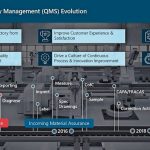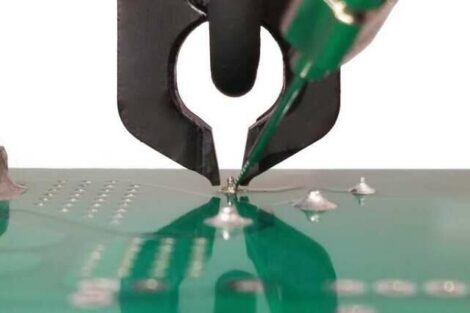There are many definitions of MES. Most systems are designed for maximum reach across industries, supporting a variety of industry segments. In some cases, certain features are critical, and in others almost irrelevant. There will probably never be a standard definition of what MES must contain or what it is expected to include. Arguments on this subject continue to evolve as expectations change based on technology advances, such as the Industrial Internet of Things (IIoT). Modern expectations are for Manufacturing Execution Systems to connect bi-directionally with automated equipment so as to reduce the amount of operator support needed and also to reduce delays for data acquisition and process control. It should provide the single digital platform that connects these differing areas, such that visibility and control of potential causes of final assembly production disruption can be gained.
Factory dependencies
The common design of production processes focuses on the main schedule that delivers the end result to customers. The idea is that this production should never be interrupted, as this would threaten the on-time delivery performance. If interruptions were to be tolerated, it would cause a reduction in productivity and a risk of late completion, which then brings the need for excess finished goods stock, a significant and needless cost for the operation. Everything on which final production is dependent must therefore be prepared in advance. This should preferably be on a “Just In Time” (JIT) basis, such that it is there when needed, but only when needed. Key dependencies to consider include material preparation, engineering data, and management of key tools, resources, and people. MES knows both the current and intended production plan, as well as the current progress of production. The sequence for the provision of materials and utilization of resources can therefore be predicted, allowing MES to manage such resources in line with final production requirements, or even to adjust the final production schedule if resource capabilities are exceeded. Manufacturing Execution Systems therefore operates in a live environment working in many areas simultaneously and with many different kinds of data, essentially a “big data” environment. The range of values that MES adds is very much up to the design and scope of the software. Basic examples will calculate and show requirements for things, then monitor progress to show performance. More advanced MES systems will manage key aspects of the dependent areas, adding value to each in terms of automation, management and traceability.
MES internal supply-chain management
Materials are a critical element for successful production. The absence of even the most humble of parts, such as the correct cable or resistor, which in themselves have almost zero cost, can mean that production cannot be completed and perhaps should not even be started. Every individual material needs therefore to be treated by Manufacturing Execution Systems as critical. ERP recognizes materials simply by part number and quantity “on site”, which starts from arrival of the raw material through to work-order completion, which is often simply a multiplication of products made, multiplied by the material counts in the Bill of Materials (BOM). Though locations of materials are supported in many ERP systems, material inventory by location cannot be relied upon, as it requires extensive manual material counting and data entry at busy times. Almost without exception, the ERP view of materials is quite different from the physical situation, due to spoilage and other unaccounted losses. The need for frequent, costly, disruptive stock-checks and resultant need for adjustments in ERP is a symptom of this issue, as well as cases where materials could not be found when needed. A basic MES system can help by providing knowledge of the movement of materials, though the ERP system will still frequently make poor planning decisions based on incorrect assumptions of material availability, which risks creating schedules that cannot be fulfilled.
The more advanced MES system will take full control of materials. This starts with the unique identification of materials, either individually for key components and sub-assemblies, or by carrier for bulk materials such as reels of SMT parts in electronics manufacturing. MES will then decide and allocate storage locations, creating and managing logistics tasks for materials operators as materials are dispersed throughout the factory, including warehouses, local stock areas and delivery to points of consumption. Mobile terminals are an ideal way for Manufacturing Execution Systems functionality to be present wherever needed, as materials are scanned into or out of locations. The requirement for material movement is best driven on Lean principles such as Kanban, and JIT delivery based on the predicted need for materials at the point of consumption. MES knows the quantity of each material required for production having full visibility of the current and near-term intended schedule, plus live feedback about progress from the production processes themselves. More advanced systems will also collect spoilage data as well as consumption data, such that near-perfect material inventory control can be maintained, which when shared back to ERP, enables ERP to make better decisions. MES systems manage advanced aspects of materials, including such things as storage environment requirements, baking cycles for moisture sensitive materials, obsolescence and expiry, as well as material substitutions against the approved BOM. Manufacturing Execution Systems technologies eliminate “internal” material shortages, meaning that production is never disrupted for lack of materials. In addition, benefits have been seen such that bloated stock inventories can be reduced by 75 %, material logistics reduced by 30%, and warehouse space reduced by 50 %. Other savings also include examples related to production space and number of carriers required. The potential savings in material related costs alone is for many, justification in itself for the purchase of an advanced MES system.
Engineering data management
Part of the job of a MES solution is to display electronic documentation at production processes. As more processes become automated, such documentation is targeted more towards the setup of the process, while the automation follows an assigned sequence of instructions. These are typically formatted and optimized using software provided by the machine vendor. The engineering data on which they are derived however comes from the design of the product and local BOM. The conversion of design and BOM data, and assignment of work to complete a product, is divided between the various automated and manual processes by MES engineering systems depending on process capabilities and throughput metrics. Without such a tool, an engineer has to read in design data from many different formats, confirm data consistency, make adjustments depending on local BOM changes, and then manually split the data out to the various systems based on their know-how. This process typically takes many days in the case of complex manufacturing, such as electronics. This process effectively dictates that engineering decides the production configuration with which to make each product in advance, with very little flexibility. While this has been seen as a “cost of doing business” in the days of high volumes and low product mix, in today’s dynamic high-mix environment, this process is not sustainable.
With advanced MES systems creating a digital product-model, taking data in electronic format from design and BOM, the conversion and assignment of work is automated following engineering preferences, taking minutes rather than days. The ability to effectively create process data on demand allows the Manufacturing Execution Systems planning function to decide which configuration is the best to use for each product, all depending on the actual condition of production and demand at the time. More flexible planning leads to significant improvement in asset utilization and productivity. The MES planning function will consider lead times throughout the product hierarchy of sub-assemblies, optimizing execution of all available configurations, changeover times, as well as product grouping strategies. This flexibility allows a step-change in the ability of the modern factory to respond to changes in customer demand, being able to smoothly make transitions across a high-mix of products, whilst keeping utilization to a maximum without the need to produce excess finished goods stock. Results seen by this practice can yield between 20 % and 50 % improvement in productivity. This resolves the traditional problem that occurs without Manufacturing Execution Systems, or with only a basic system, where productivity declines very sharply as product mix increases, leading to increased costs and investment.
Zusammenfassung Résumé Zusammenfassung russisch
Der Artikel gibt einen Einblick darüber, wie und wo ein MES-System arbeitet, um abhängige Ressourcen in der Fabrik zu verwalten, die den reibungslosen und effektiven Ablauf des endgültigen Produktionsflusses ermöglichen.
L‘article décrit comment un système MES fonctionne pour gérer les ressources dépendantes dans l‘usine, ce qui permet le bon déroulement de la production finale.
Статья приводит точку зрения на то, как и где работает MES-система для управления независимыми ресурсами на фабрике, которые обеспечивают безупречное и эффективное выполнение конечного производственного процесса.












